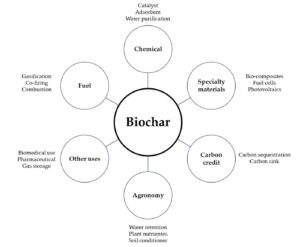Biochar’s History as an Ancient Soil Amendment— Biochar is a form of charcoal produced from super-heating biomass. It is found naturally in soils around the world as a result of vegetation fires.
Biochar is created through a process called pyrolysis, it can come from residual products and waste that would not otherwise be useful. Even better, biochar is effective in all types of vegetation and green areas. That means we can use it in home and urban environments too.
 Production and use of biochar is drawing increasing attention globally within politics, green NGOs, metal industry, agriculture, soil physics, geo engineering, development of construction and filter materials, waste management, and many, many more.
Production and use of biochar is drawing increasing attention globally within politics, green NGOs, metal industry, agriculture, soil physics, geo engineering, development of construction and filter materials, waste management, and many, many more.
Biochar has the potential to:
- capture toxins and excess nitrogen protecting our waterways and groundwater quality,
- in making biochar, create an alternative energy source for generating heat and power, and valuable by-products of syngas and bio-fuels, thereby reducing CO2 emissions,
- reduce the need for (and use of) fossil-fuels and fossil-fuel based fertilizers,
- turn biomass and bio waste into value-added products while creating jobs, and
- safely sequester CO2 for thousands of years which slows climate change.
We also supply biomass for the biochar production-
https://www.linkedin.com/posts/arigna-fuels-ltd_harvestflame-biochar-biocharplant-activity-7130884923892080640-X1X_?utm_source=share&utm_medium=member_desktop
https://www.linkedin.com/posts/arigna-fuels-ltd_harvestflame-arignafuels-biocharplant-activity-7127637367166791680-oYcY?utm_source=share&utm_medium=member_desktop
Interesting articles-
The Biochar Journal
https://www.biochar-journal.org/en/home
Science of The Total Environment
https://www.sciencedirect.com/science/article/abs/pii/S0048969722080937
Pyrolysis promotes sustainable manure and biomass disposal.
Pyrolysis biochar enhances soil remediation and crop yields.
Cross-interaction of volatiles from co-pyrolysis enhance biochar functionalities.
Heavy metals of animal manures are fixated in biochar.
Biochar improves soil nutrient retention capability.
Frobs, Nov. 29, 2022
https://www.forbes.com/sites/robday/2022/11/29/carbon-offset-markets-why-are-investors-jumping-in/?sh=52450a07f595
“What areas seem especially interesting to you after mapping out the market?
If you’ve been following the markets for the past few months, you would be hard-pressed to miss the buzz surrounding biochar producers. Biochar is a charcoal-like substance created through the pyrolysis of waste materials and can be used for fertilizer, the improvement of soil quality, fuel, and several other applications. These projects are fascinating because not only are the developers selling an environmentally sustainable and financially lucrative product, but they are often eligible for an additional revenue stream through carbon removal credits. Carbon removal credits are issued and generated via similar processes as offsets, but instead of rewarding emission reductions, they are awarded for activities that sequester carbon. Despite being slightly newer than offsets, these biochar-generated carbon removal credits are now being issued by more well-known registries such as Verra, which recently created its first biochar protocol this summer. Additionally, the market for these products is increasing which motivated even more compelling prices; a notable example being Shopify and Carbofex’s long-term deal this Spring.”

